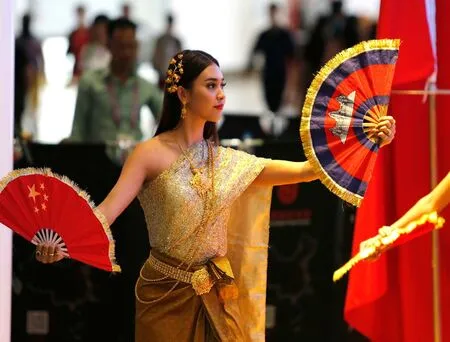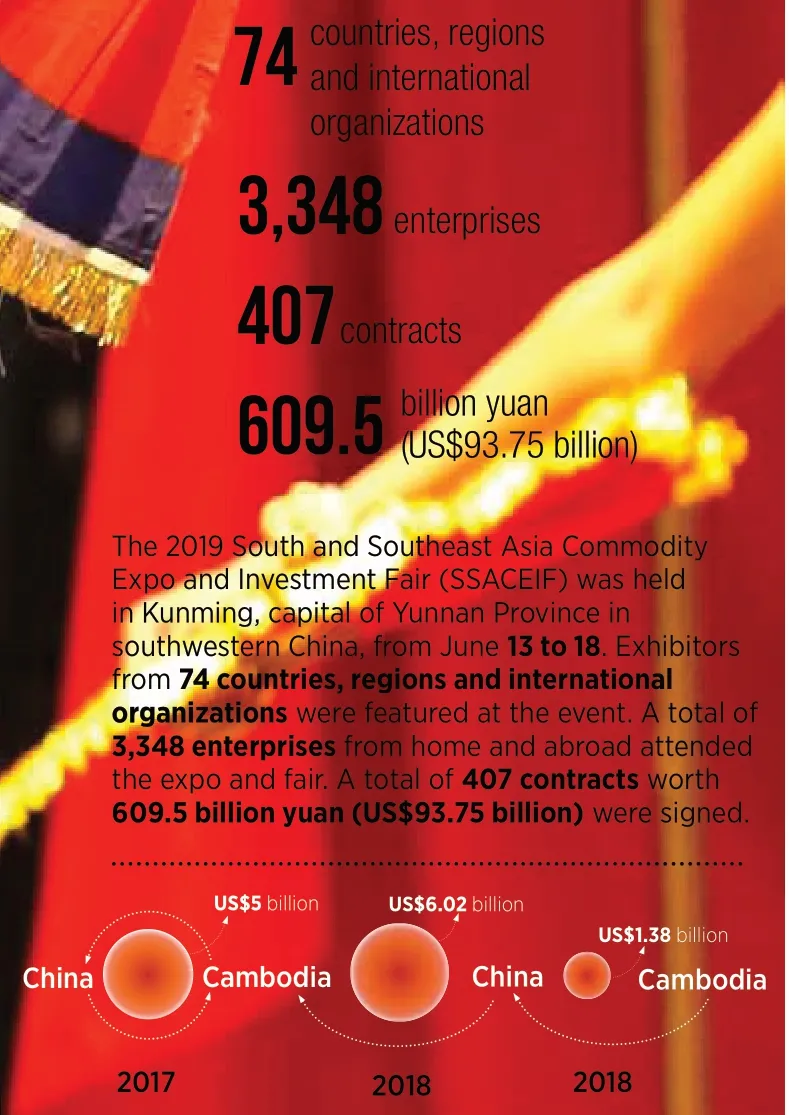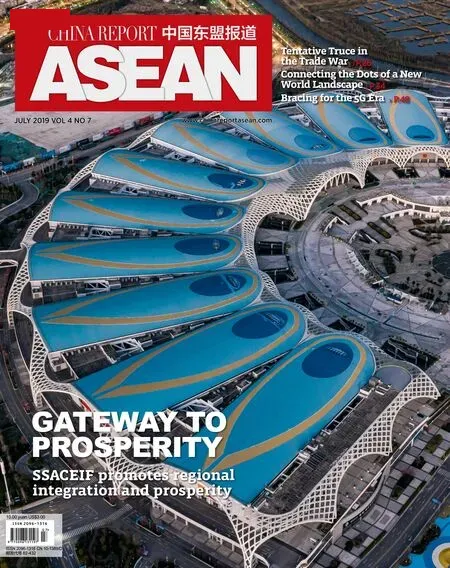UNITING IN YUNNAN
By Wang Fengjuan

A Cambodian dancer performs with Chinese and Cambodian national flag fans at the 2019 SSACEIF in Kunming,Yunnan Province.
The 2019 SSACEIF promotes regional integration and prosperity

T he 2019 South and Southeast Asia Commodity Expo and Investment Fair (SSACEIF)was held in Kunming, capital of Yunnan Province in southwestern China, from June 13 to 18. Exhibitors from 74 countries, regions and international organizations were featured at the event. A total of 3,348 enterprises from home and abroad attended the expo and fair. A total of 407 contracts worth 609.5 billion yuan(US$93.75 billion) were signed. The event has built a platform for mutually beneficial cooperation between China and South and Southeast Asian countries.
In the Southeast Asia Exhibition Hall, the booth for Vietnam Biti's, a Vietnamese footwear brand, attracted many visitors. “Biti's is well-known to Chinese customers for its slippers,”explained the booth manager. “Our sales volume during the seven-day expo has far exceeded what we do in an average month. The event provides a very good platform for us to show customers our products and search for opportunities for mutually beneficial cooperation. We hope to find a regional distributor for our products.”
Already considered a solid platform,the SSACEIF has continuously attracted foreign exhibitors eyeing a bigger share of the Chinese market through Yunnan Province.
Authentic Specialties
In the Hall of Cambodia, dedicated to the guest of honor of this year's SSACEIF, a big picture of Chinese President Xi Jinping with Cambodian Prime Minister Hun Sen was on display. The interior decoration of the hall featured strong Khmer flavors including plentiful yellow, wooden corridors and arched doors. Adorning the walls were big pictures of famous scenic spots in Cambodia such as Angkor Wat, the Royal Palace, Tonle Sap Lake and Sihanoukville Beach.
Chhuon Dara, Secretary of State under the Ministry of Commerce of Cambodia, believes that Cambodia's participation in expos and fairs in China has effectively promoted bilateral economic and trade cooperation. In 2017, the total value of bilateral trade between the two countries reached US$5 billion. In 2018, Cambodia's import of goods and services from China was worth US$6.02 billion,while its exports to China were valued at US$1.38 billion. “I'm fully confident that Cambodia will achieve results,expand into new markets, make new partners and obtain new projects through this platform,” said Dara. “We would also like to attract more Chinese tourists to visit Cambodia.”
“This is my first trip to Kunming,”revealed Kim Leang, the lead dancer in a small Cambodian dance troupe.“We performed traditional Cambodian dancing to pray for blessings for the Chinese people in Nanning. I hope our performance will help more Chinese people understand Cambodian culture.”
The Hall of Cambodia featured 48 booths for 20 private businesses from Cambodia in its floor space of 600 square meters. During the 2019 SSACEIF, Cambodian exhibitors mingled with businesspeople from China and other parts of the world to promote commodities, tourism and investment projects.

A visitor tries on a majestic straw hat at the 2019 SSACEIF in Kunming, Yunnan Province.
In the Hall of Southeast Asia, a variety of special commodities went on display including gemstones from Myanmar, latex pillows from Thailand,white coffee from Malaysia, jasmine rice from Laos, traditional costumes from Indonesia and bamboo-rattan knitted products from Vietnam.Visitors and locals could buy products from different countries and enjoy a nibble of various cultures. A booth of Thai clay flowers and polymer clay jewelry was particularly popular.The hostess, dressed in colorful national costume, was all smiles as she introduced beautiful earrings,necklaces, headdress flowers and other products.
At a booth filled with food products, a host greeted visitors with hot Thai Tom Yum Kung soup. “The soup was great,”reported a local resident. “It tastes sour and hot—very unique. I think their products could find a lot of fans.”
Win-Win Cooperation
In recent years, Yunnan Province has become more and more closely connected to international and domestic markets, especially the markets of neighboring countries. In the spirit of extensive consultation,joint contributions and shared benefits, everyone involved in SSACEIF emanated sincere hope for mutually beneficial win-win cooperation.
“Sister, please check out my beautiful gemstones,” pleaded Daw Nang Mai, an exhibitor from Myanmar. The dark-faced man who speaks fluent Chinese owns a small gemstone business based on the China-Myanmar border. This was his fifth time to attend the expo to continue expansion of his operation. The woman balked at the suggested price. “Fine, I can give you a discount,” he grinned. “It's going to be a win-win deal.”
Since construction of the Belt and Road commenced, China and Myanmar have strengthened cooperation in trade and their cross-border trade has prospered. Ye Min Aung, vice president of the Union of Myanmar Federation of Chambers of Commerce and Industry,considers BRI very important for the development of ASEAN and its member states. Within the framework of the BRI, Myanmar is enthusiastic about cooperating with China and other ASEAN countries in fields of renewable energy, new agriculture, industrial projects and infrastructure. Myanmar also seeks to cooperate more in capital markets. Myanmar has established the Yangon Stock Exchange and is in the process of forming the Mandalay Stock Exchange. “We would love support from China and other ASEAN countries,” said Aung.
“Laos is a land-locked country,”explained Thanongsinh Kanlagna, vice president of the Lao National Chamber of Commerce and Industry (LNCCI),“Our strategy is to transform Laos into a land-linked country. China is the largest foreign investor in Laos, followed by Thailand and Vietnam. We now have 11 priority areas for investment. At the top of the list is energy, followed by agriculture and manufacturing. We have built 12 special economic zones and centers offering a series of preferential policies to attract foreign investment.Our goal is to promote the quality and brand of ‘Made in Laos' to the world.”
“In 2018, Vietnam's economy grew by 7.08 percent, a record high in 10 years,” pointed out Bui Trung Nghia, deputy general secretary of the National Chamber of Commerce and Industry of Vietnam (VCCI), “Foreign direct investment [FDI] surpassed US$35 billion. China is now the seventh largest source of FDI for Vietnam, and it has been Vietnam's largest trading partner since 2004. Volume of bilateral trade in 2018 was US$104.6 billion,an increase of nearly 12 percent over 2017. The Vietnamese government will continue to improve our business environment to attract more foreign investment. It will also continue to improve bilateral trade between Vietnam and China, especially through Yunnan Province.”
“Thailand and China have long remained very close partners in bilateral trade and economic cooperation,” commented Achana Limpaitoon, deputy secretary general of the Sino-Thai Industrial Cooperation Committee of the Federation of Thai Industries (FTI). “China is a major investor in the Eastern Economic Corridor in Thailand. Thailand attaches great importance to investment cooperation with China, especially in connectivity projects. Within the framework of the BRI, innovation and entrepreneurship will drive the economic development of Thailand.”

Digital technologies and their application were highlights of this SSACEIF. All exhibition areas offered 5G WiFi signals. Cutting-edge digital technologies such as 4K (ultra-high definition video), AI, augmented reality (AR) and virtual reality(VR) were demonstrated. A liquid metal 3D pen capable of writing circuits debuted. Facial recognition at gas stations and robotic security check were also attractive.
With geographical proximity,cultural affinity, business connectivity and profound friendship with the neighboring countries in South and Southeast Asia, Yunnan Province is seizing the opportunities of SSACEIF to promote practical cooperation,unleash development potential and realize economic integration to promote interconnected development and sharing of achievements.
Yunnan's Geographic Advantage
In recent years, Yunnan has made remarkable achievements in connectivity infrastructure,especially the continuous improvement and expansion of its transportation network.Nattapong is sales manager of a Thai seasoning products manufacturer. “We came to this expo with samples of our products,” he said. “We traveled by air. It was very quick and easy.There are more than 20 flights a day from Bangkok to Kunming.”
Kunming is located at the center of a five-hour air transport circle in Asia. Many air routes linking China and various countries in South and Southeast Asia pass over Kunming. From Kunming, a traveler can find a direct flight to almost any major airport in South Asia, Southeast Asia and Northeast Asia.
Yunnan meets the Silk Road Economic Belt to its north and the 21st Century Maritime Silk Road to its south. It is the only Chinese province with land routes connecting to both South Asia and Southeast Asia. In recent years,Yunnan has actively participated in the construction of the Belt and Road, enhancing its business connectivity and cooperation with domestic and international partners, especially those from the neighboring countries.
Yunnan agricultural products such as tobacco, tea, flowers,herbal medicines and coffee are popular in domestic and international markets. With the transformation and upgrading of its foreign trade, the province has accelerated its international production capacity cooperation in fields of power, equipment manufacturing, metallurgy,chemical industry, building materials, light industry and logistics. It has earned a sterling reputation in international markets thanks to advanced technology, high-quality products, scientific management and a strong sense of social responsibility.
In the Hall of Green Energy,visitors were attracted to an exhibition presented by Chinese power enterprises China Three Gorges Corporation, State Power Investment Corporation(SPIC), China Southern Power Grid Company (CSG) and China Huaneng Group. A 3D model of the Lower Sesan 2 Hydropower Dam, a China-Cambodia energy cooperation project, was the most popular. The hydropower project is the largest in Cambodia, and was jointly developed by three parties: Yunnan Hydrolancang International Energy, the Royal Group of Cambodia and the Electricity of Vietnam (EVN)International. The power plant began production on December 27, 2018. Equipped with eight 50,000-kilowatt light bulb tubular turbine units made in China, the plant offers a total installed capacity of 400,000 kilowatts and an annual capacity of 1.97 billion kilowatt-hours.
CSG has also actively connected its power grids with those of the neighboring countries to promote local social and economic development.Its power grids reach Vietnam,Laos and Myanmar through 12 transmission lines at voltage levels of 110 kV and above.Furthermore, CSG grants scholarships to students from Southeast Asian countries such as Vietnam, Myanmar, Laos and Cambodia seeking to major in power-related subjects at Yunnan University of Technology or Guangxi University.
China's door will remain open and only continue widening.As host of the SSACEIF, Yunnan has embraced the opportunity to serve on the frontier of China's opening-up and as a hub of the Belt and Road. The SSACEIF has become a platform for Chinese and foreign cooperation partners to connect. Industry barriers have been broken, and investment environments have been optimized.
Yunnan's Fudian Bank joined Lao Foreign Trade Bank (BCEL)to establish Lao-China Bank(LCNB), which has become a model for local commercial banks to go global. Yunnan has built five demonstration parks for overseas agricultural science and technology cooperation in Laos, Vietnam and Cambodia as well as numerous exportoriented public technical service platforms such as the China-Laos renewable energy platform and the China-Sri Lanka joint laboratory for the development and utilization of biological resources.
The live 2019 SSACEIF has closed, but its online companion,the “Never-Closing SSACEIF,” is online. China, including Yunnan,will continue its drive to open up and cooperate with the rest of the world.

